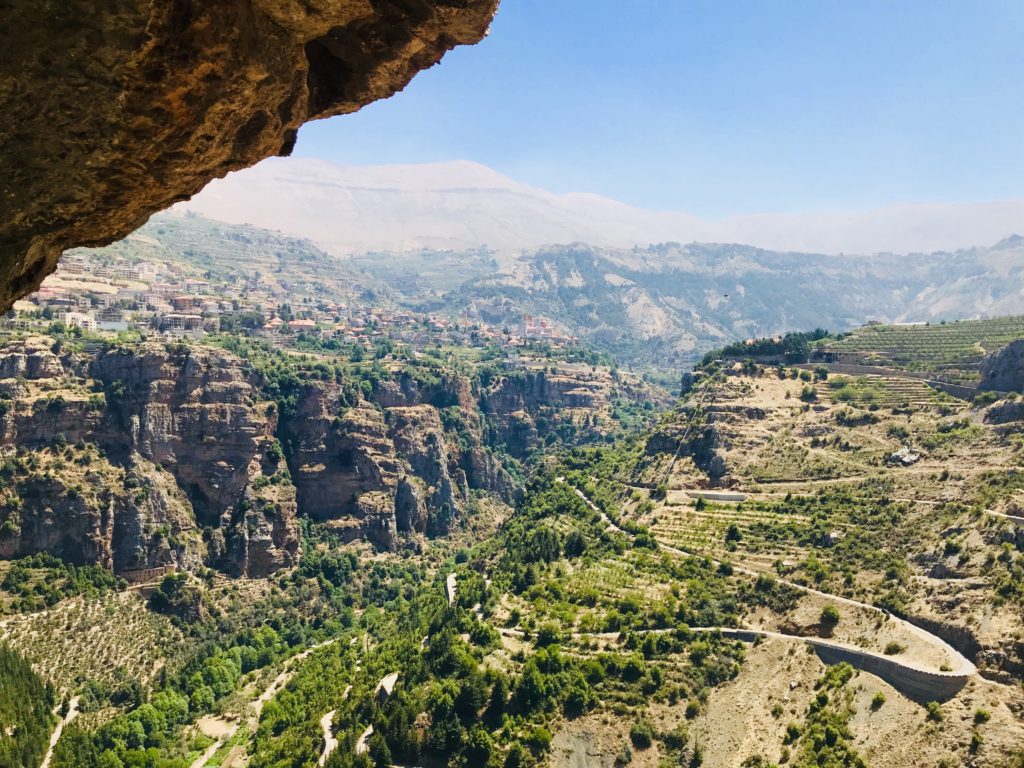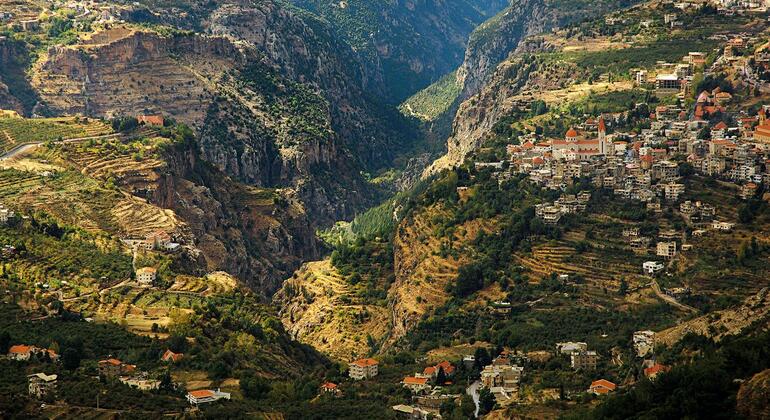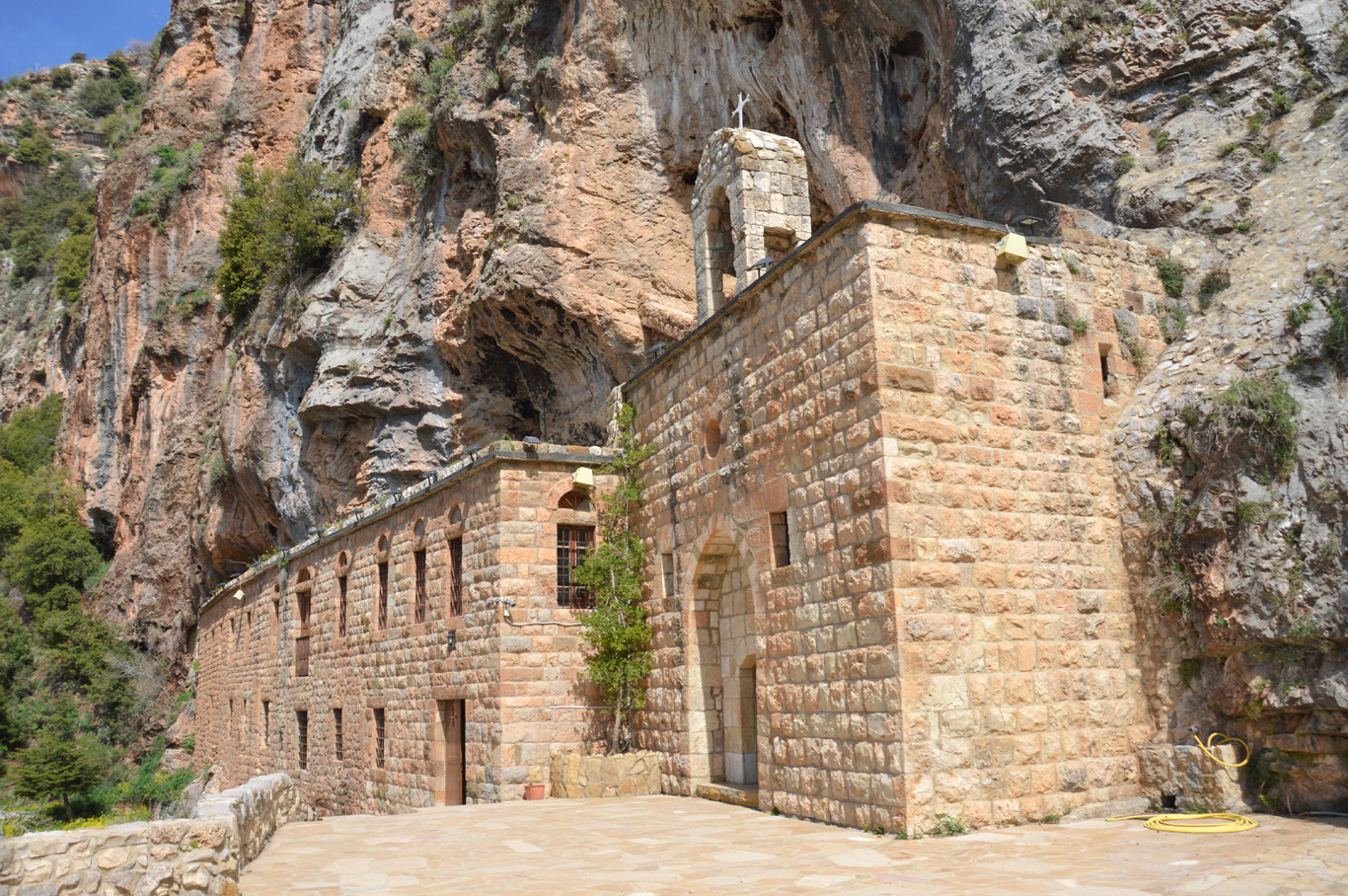A Guide to the Qadisha Valley, Lebanon

If you are a nature enthusiast or a history buff, the Qadisha Valley in Lebanon is a destination that should be on your bucket list. This picturesque valley is known for its stunning natural beauty and rich historical and cultural significance.
Overview of the Qadisha Valley and its significance in Lebanon's history and culture
The Qadisha Valley, also known as the Holy Valley, is located in northern Lebanon and inhabited for thousands of years. Its deep gorges, towering cliffs, and lush greenery make it a paradise for hikers and nature lovers.
But what truly sets the Qadisha Valley apart is its historical and cultural importance. The valley has been a refuge for Christian monastic communities since the early centuries of Christianity. The monasteries built into the cliffs are not only architectural marvels but also serve as a testament to the enduring faith of the people who sought solace and spirituality in this secluded valley.
The Qadisha Valley is also home to numerous archaeological sites, including ancient churches, hermitages, and caves once inhabited by monks. These sites provide a glimpse into the region's past and offer a unique opportunity to explore Lebanon's rich heritage.
In addition to its historical significance, the Qadisha Valley is also a UNESCO World Heritage site. Its exceptional natural beauty and cultural and religious importance have earned it this prestigious recognition.
Whether you are an avid hiker looking to explore its scenic trails or a history enthusiast eager to delve into Lebanon's past, the Qadisha Valley offers something for everyone. So pack your bags, put on your hiking boots, and get ready to embark on an unforgettable journey through one of Lebanon's most captivating destinations.

Getting to the Qadisha Valley
Directions and transportation options to reach the valley
If you're planning a trip to Lebanon, the Qadisha Valley is a must-visit destination that offers breathtaking natural beauty and rich cultural heritage. Here's a guide on how to get there.
By Car:
Driving to the Qadisha Valley is a popular option for those who prefer flexibility and independence. From Beirut, you can take the highway towards Tripoli, then follow signs for Bcharre. The journey takes approximately two hours, depending on traffic conditions. Once you reach Bcharre, you can explore the valley by car or join guided tours.
By Public Transportation:
If you prefer public transportation, there are several options available. From Beirut, you can take a bus or shared taxi (known as "service") to Bcharre. The journey takes around three hours, and buses depart regularly from Charles Helou Station. Once in Bcharre, you can hire a local guide or join organized tours to explore the valley.
By Tour:
Another convenient option is to join organized tours that include transportation to the Qadisha Valley. Many tour operators offer day or multi-day excursions that provide a comprehensive experience of the valley's beauty and history. These tours often include visits to monasteries, hiking trails, and other points of interest.
Whether you drive, take public transportation, or join a tour, reaching the Qadisha Valley is an adventure. The scenic journey through winding mountain roads offers stunning views of Lebanon's picturesque landscapes.
Once you arrive at the Qadisha Valley, be prepared to be amazed by its towering cliffs, lush forests, and ancient monastic settlements. Exploring the valley's hiking trails will lead you to hidden gems like the Monastery of Qozhaya and the Cedar Forest Nature Reserve.
Remember to bring comfortable shoes, water, and a camera to capture the beauty of this UNESCO World Heritage Site. Enjoy your journey to the Qadisha Valley and immerse yourself in its natural wonders and cultural treasures.

Exploring the Qadisha Valley
If you're looking for a breathtaking adventure in Lebanon, the Qadisha Valley should be at the top. Nestled in the heart of the country, this UNESCO World Heritage Site offers a unique blend of natural beauty and rich history. Here's a guide to help you make the most of your visit.
Top attractions and landmarks in the valley, including:
a. Monasteries in the Qadisha Valley
The Qadisha Valley is home to several ancient monasteries that have stood the test of time. These monasteries offer a glimpse into the spiritual and cultural heritage of the region. Here are three must-visit monasteries:
Mar Lishaa Monastery
Perched on a cliffside, Mar Lishaa Monastery offers stunning views of the valley below. This monastery dates back to the 8th century and is known for its beautiful frescoes and intricate architecture.
Qozhaya Monastery
Qozhaya Monastery is one of the oldest monastic settlements in the valley, dating back to the 4th century. It is famous for its library, which houses a vast collection of ancient manuscripts and religious texts.
Deir Qannoubine Monastery
Deir Qannoubine Monastery is nestled deep within the valley and is surrounded by towering cliffs. This monastery served as the seat of the Maronite Patriarchate for several centuries and is a symbol of religious significance.
b. Hiking Trails in the Qadisha Valley
For nature enthusiasts, the Qadisha Valley offers a variety of hiking trails that showcase its stunning landscapes. Two popular trails are:
Qadisha Valley Trail
The Qadisha Valley Trail is a moderate hike that takes you through the valley's heart. You'll pass by ancient caves, terraced fields, and picturesque villages along the way.
The Cedars of God Trail
This trail leads you to the famous Cedars of God, a grove of ancient cedar trees revered for centuries. The trail offers breathtaking views of the valley and is a must-visit for nature lovers.
Whether exploring the monasteries or hiking through the valley, the Qadisha Valley promises an unforgettable experience that will leave you in awe of Lebanon's natural and cultural heritage.

History and Cultural Heritage of the Qadisha Valley
Discover the historical and cultural significance of the valley, including:
a. The Valley as a UNESCO World Heritage Site
Welcome to the breathtaking Qadisha Valley in Lebanon! This picturesque valley holds immense historical and cultural significance, so it has been recognized as a UNESCO World Heritage Site. The valley's rugged cliffs, deep gorges, and lush vegetation create a stunning backdrop for its rich history.
The Qadisha Valley is home to numerous monastic communities that date back to the early Christian era. These monasteries, some still active today, were established by hermit monks seeking solitude and spiritual enlightenment. The valley's remote location provided the perfect sanctuary for these monks, allowing them to live in harmony with nature and focus on their religious practices.
b. The Influence of Christianity in the Qadisha Valley
The Qadisha Valley has played a significant role in developing and preserving Christianity in Lebanon. The monasteries and churches scattered throughout the valley are not only architectural marvels but also important pilgrimage sites for Christians worldwide.
The valley's spiritual atmosphere and serene surroundings make it ideal for contemplation and reflection. Visitors can explore ancient churches, admire beautiful frescoes, and witness the daily lives of monks who have dedicated themselves to a life of prayer and devotion.
Throughout history, the Qadisha Valley has symbolised resilience and faith. It has withstood numerous challenges and conflicts, yet its spiritual essence remains intact. Today, it inspires visitors with its natural beauty and profound connection to Christianity.
Whether you are a history enthusiast or simply seeking a peaceful retreat, the Qadisha Valley offers a unique and enriching experience. Immerse yourself in its captivating history, explore its hidden treasures, and discover the profound cultural heritage that has shaped this remarkable valley for centuries.

Local Cuisine in the Qadisha Valley
Traditional Lebanese dishes and local specialities to try in the valley
When visiting the beautiful Qadisha Valley in Lebanon, one of the highlights of your trip should be exploring the local cuisine. Lebanese food is known for its rich flavours, fresh ingredients, and unique combinations that will leave your taste buds wanting more. Here are some traditional dishes and local specialities that you must try during your visit:
-
Tabbouleh: This refreshing salad is made with finely chopped parsley, bulgur wheat, tomatoes, onions, and a zesty dressing of lemon juice and olive oil. It is a perfect starter to awaken your palate.
-
Hummus: A staple in Lebanese cuisine, hummus is a creamy dip made from mashed chickpeas, tahini, garlic, lemon juice, and olive oil. Enjoy it with warm pita bread for a satisfying snack.
-
Kibbeh: This popular dish consists of ground meat (usually lamb or beef) mixed with bulgur wheat, onions, and spices. It is shaped into patties or balls and fried or baked to perfection.
-
Falafel: These crispy, deep-fried balls are made from ground chickpeas or fava beans mixed with herbs and spices. They are often served in pita bread with tahini sauce and fresh vegetables.
-
Moussaka: Not to be confused with the Greek dish of the same name, Lebanese moussaka is a flavorful casserole made with eggplant, tomatoes, onions, chickpeas, and spices. It is a hearty vegetarian option.
-
Baklava: End your meal on a sweet note with baklava, a rich and decadent pastry made with layers of filo dough, nuts, and honey syrup. It is a delightful treat showcasing Middle Eastern influence in Lebanese cuisine.
Exploring the local cuisine in the Qadisha Valley is a culinary adventure and a cultural experience. Embrace the flavours, savor each bite, and immerse yourself in the vibrant food scene of Lebanon.

Accommodation Options in the Qadisha Valley
Recommendations for hotels, guesthouses, or campsites in or around the valley
When planning your visit to the breathtaking Qadisha Valley in Lebanon, it's essential to consider your accommodation options. Whether you prefer the comfort of a hotel, the charm of a guesthouse, or the adventure of camping, choices are available to suit every traveller's preferences.
Hotels:
- Hotel Le Cedrus: Located in Bcharre, this hotel offers stunning views of the valley and is known for its excellent service and comfortable rooms. It's an ideal choice for those seeking a luxurious stay.- The Tamer Land Hotel: Situated in Ehden, this hotel combines modern amenities with traditional Lebanese architecture. Guests can enjoy spacious rooms and a relaxing atmosphere surrounded by nature.- The Chbat Hotel: Found in Bcharre, this hotel is famous for its panoramic views of the valley and proximity to attractions such as the Gibran Museum. It offers comfortable rooms and a warm ambience.
Guesthouses:
- Dar Linda: Located in Hasroun, this charming guesthouse offers cosy rooms with traditional decor. Guests can enjoy homemade Lebanese cuisine and experience the warm hospitality of the hosts.- Villa Paradiso: Situated in Bcharre, this guesthouse provides a tranquil retreat with beautiful gardens and comfortable rooms. It's an excellent choice for those looking for a peaceful stay.
Campsites:
- Camping Les Colombes: This campsite is nestled in the heart of the Qadisha Valley and offers stunning views of the surrounding mountains. It provides basic facilities for campers and is perfect for those seeking a closer connection with nature.- Camping La Reserve: Located near the Cedars of God, this campsite offers a serene environment surrounded by cedar trees. It provides amenities such as showers and toilets for campers.
No matter which accommodation option you choose, staying in or around the Qadisha Valley will allow you to fully immerse yourself in the natural beauty and rich history of this UNESCO World Heritage site.

Safety Tips and Travel Advisory
Important information and precautions for a safe and enjoyable visit to the Qadisha Valley
Planning a trip to the beautiful Qadisha Valley in Lebanon? Here are some important safety tips and travel advisories to ensure your visit is safe and enjoyable.
-
Research and Plan: Before embarking on your journey, research the current situation in the area. Check for any travel advisories or warnings your government or local authorities issued. It's always better to be well-informed before you go.
-
Stay on Designated Paths: The Qadisha Valley is known for its stunning hiking trails. While exploring the valley, stick to designated paths and avoid venturing into unknown areas. This will help ensure your safety and protect the delicate ecosystem of the valley.
-
Inform Others: Tell someone about your travel plans, including your itinerary, expected return time, and emergency contact information. This way, if anything unexpected happens, help can be easily reached.
-
Stay Hydrated: The Qadisha Valley can get hot during the summer months, so staying hydrated is important. Carry plenty of water with you and drink regularly to prevent dehydration.
-
Respect Local Customs: Lebanon has a rich cultural heritage and traditions. Show respect for the local customs and traditions while visiting the Qadisha Valley. Dress modestly, especially when visiting religious sites, and be mindful of local sensitivities.
-
Protect the Environment: The Qadisha Valley is a UNESCO World Heritage site known for its unique natural beauty. Help preserve this pristine environment by not littering, avoiding damage to flora and fauna, and following any guidelines or rules set by the authorities.
Remember, safety should always be a top priority when travelling. By following these tips and being mindful of your surroundings, you can have a safe and memorable experience exploring the Qadisha Valley in Lebanon.
